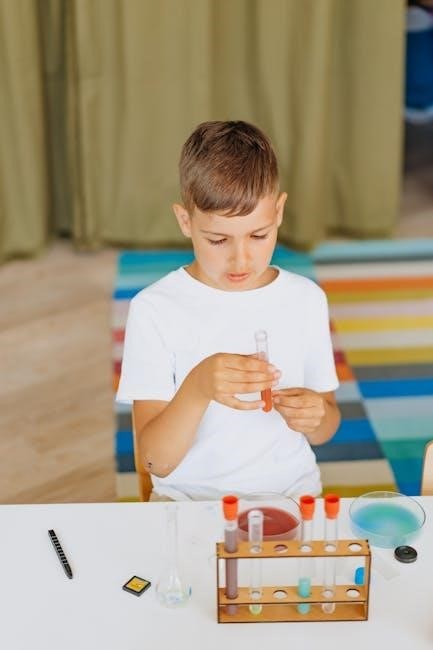STEM activities for preschoolers lay the groundwork for future skills‚ fostering curiosity and creativity through hands-on exploration of science‚ technology‚ engineering‚ and math concepts in a playful‚ age-appropriate manner․
1․1 What is STEM Education?
STEM education integrates science‚ technology‚ engineering‚ and mathematics to foster critical thinking‚ creativity‚ and problem-solving skills․ It encourages interdisciplinary learning‚ where concepts from each field connect to real-world applications․ STEM focuses on hands-on experiences‚ promoting innovation and adaptability․ For preschoolers‚ STEM is simplified into playful‚ age-appropriate activities that build foundational skills‚ sparking curiosity and preparing them for future academic and professional opportunities in a rapidly evolving world․
1․2 Importance of Early STEM Learning
Introducing STEM concepts early fosters foundational skills like problem-solving‚ critical thinking‚ and creativity․ It builds curiosity and confidence‚ preparing children for a technology-driven world․ Early exposure enhances logical reasoning and spatial awareness‚ while encouraging collaboration and perseverance; STEM learning at a young age also nurtures a growth mindset‚ helping children view challenges as opportunities to learn and grow․ By integrating STEM into preschool activities‚ educators lay the groundwork for future academic success and lifelong STEM exploration․
1․3 How STEM Activities Benefit Preschoolers
STEM activities for preschoolers foster creativity‚ problem-solving‚ and critical thinking․ They encourage curiosity and confidence‚ helping children explore the world around them․ Hands-on experiences enhance fine motor skills and hand-eye coordination while introducing basic concepts like cause-and-effect and patterns․ STEM play also promotes collaboration and communication‚ teaching children to share ideas and work together․ These activities lay the foundation for future academic success by building a strong understanding of essential skills in a fun and engaging way․

Setting Up STEM Activities for Preschoolers
Creating a STEM-friendly environment involves gathering simple materials‚ ensuring safety‚ and fostering curiosity․ It encourages hands-on learning‚ exploration‚ and creativity in young children through structured yet playful activities․
2․1 Creating a STEM-Friendly Environment
Creating a STEM-friendly environment for preschoolers involves designing a space that encourages curiosity‚ exploration‚ and hands-on learning․ Use everyday materials like blocks‚ magnets‚ and natural objects to spark interest․ Organize the space to promote accessibility and safety‚ ensuring children can easily engage with materials․ Incorporate technology‚ such as tablets with educational apps‚ to introduce digital tools․ Label STEM stations clearly and rotate activities to keep children engaged․ This setup fosters a sense of wonder and lays the foundation for future STEM skills‚ making learning fun and interactive․
2․2 Essential Materials and Tools for STEM Activities
Essential materials for preschool STEM activities include building tools like LEGO DUPLO‚ magnetic tiles‚ and wooden blocks․ Science tools such as magnifying glasses‚ simple microscopes‚ and sensory bins with rice‚ beads‚ or sand encourage exploration․ Art supplies like crayons‚ markers‚ and paper are crucial for creative expression․ Digital tools like kid-friendly tablets with STEM apps and interactive games introduce technology basics․ Recycled materials‚ such as cardboard boxes and bottle caps‚ promote environmental awareness and creative engineering․ These materials foster hands-on learning‚ creativity‚ and problem-solving skills‚ making STEM accessible and engaging for young children․
2․3 Safety Guidelines for Preschool STEM Experiments
Safety is paramount in preschool STEM experiments․ Always supervise children during activities and ensure materials are non-toxic and age-appropriate․ Use protective gear like goggles and gloves when handling materials․ Prepare a safe workspace by clearing the area of hazards and securing heavy objects․ Teach children to handle materials gently and avoid small parts that may pose choking risks․ Keep a first aid kit nearby and ensure fire extinguishers are accessible․ Encourage children to wash hands after experiments and clean up materials properly․ Safety fosters confidence and responsible learning in young explorers․

Science Activities for Preschoolers
Spark curiosity in preschoolers with simple‚ hands-on science activities like baking soda volcanoes and color mixing․ These experiments foster scientific thinking and a love for exploration in young learners․
3․1 Simple Science Experiments for Young Children
Engage preschoolers with easy‚ fun science experiments like mixing baking soda and vinegar to create fizzy reactions or growing plants in small pots․ These activities introduce basic scientific concepts․
- Color mixing: Combine food coloring and water to show how colors blend․
- Density exploration: Layer different liquids to demonstrate density․
- Nature observations: Collect leaves and rocks for hands-on exploration․
These experiments encourage curiosity‚ observation‚ and critical thinking in young learners while keeping them excited about science․
3․2 Exploring Nature and the Outdoors
Exploring nature and the outdoors offers preschoolers hands-on STEM learning opportunities․ Activities like nature walks‚ scavenger hunts‚ and observing seasonal changes encourage curiosity and exploration․ Collecting leaves‚ rocks‚ or flowers helps children develop observation skills and an appreciation for the natural world․ Outdoor play also introduces basic concepts of ecosystems‚ weather patterns‚ and the life cycle of plants and animals․ These experiences foster critical thinking and a foundation for environmental awareness‚ making STEM learning fun and accessible in real-world contexts․
3․3 Hands-On Activities for Scientific Thinking
Hands-on activities are essential for developing scientific thinking in preschoolers․ Simple experiments‚ such as planting seeds or mixing baking soda and vinegar‚ encourage observation and prediction․ Building bridges with blocks or creating patterns with natural materials fosters problem-solving and critical thinking․ These activities allow children to explore cause-and-effect relationships‚ ask questions‚ and draw conclusions‚ laying the foundation for a curiosity-driven approach to learning․ Play-based STEM experiences make complex concepts accessible and fun‚ while nurturing creativity and analytical skills from an early age․

Technology Integration in Preschool STEM
Integrating technology‚ like tablets and educational apps‚ introduces preschoolers to coding basics and digital tools‚ fostering early tech literacy and STEM exploration through interactive‚ engaging learning experiences․
4․1 Age-Appropriate Digital Tools for Preschoolers
Digital tools designed for preschoolers should be simple‚ interactive‚ and educational‚ fostering STEM skills through play․ Examples include apps that teach shapes‚ colors‚ and basic coding concepts․
- Tablets with kid-friendly interfaces
- Educational apps focusing on problem-solving
- Interactive games that promote STEM exploration
These tools must ensure safety‚ with parental controls and age-appropriate content‚ while encouraging creativity and critical thinking through engaging visuals and hands-on activities․
4․2 Coding Basics for Young Children
Coding basics for preschoolers introduce foundational concepts through play․ Simple activities‚ like sequencing blocks or following directions‚ teach logic and problem-solving skills․ Digital tools‚ such as kid-friendly coding apps‚ use visual cues and games to make learning interactive․ These activities help children understand cause-and-effect relationships and build critical thinking abilities․ By using relatable examples‚ like arranging puzzles or creating patterns‚ young learners develop essential skills for future STEM exploration․
- Sequencing games
- Visual programming tools
- Interactive storytelling
4․3 Using Educational Apps for STEM Learning
Educational apps offer engaging ways to introduce STEM concepts to preschoolers․ Interactive games and puzzles teach shapes‚ colors‚ and basic math through play․ Many apps align with learning goals‚ such as problem-solving and logical thinking․ Features like animations and voice guidance make complex ideas accessible․ Parents and educators can choose apps with minimal text and intuitive interfaces‚ ensuring they suit young learners․ These tools foster a love for STEM while providing a fun‚ screen-based learning experience that complements hands-on activities․
- Interactive STEM-themed games
- Visual learning tools
- Age-appropriate problem-solving exercises

Engineering and Building Activities
Engineering and building activities spark creativity and problem-solving skills in preschoolers‚ encouraging them to design‚ construct‚ and innovate using everyday materials like blocks and LEGO․
Introducing engineering concepts to preschoolers involves simple‚ engaging activities that foster curiosity and creativity․ Using everyday materials like blocks‚ LEGO‚ or magnetic tiles‚ children can explore basic engineering principles․ These activities encourage problem-solving and critical thinking while developing fine motor skills․ Introducing terms like “design‚” “build‚” and “test” helps preschoolers connect their play with real-world engineering practices․ Hands-on experiences‚ such as building bridges or creating structures‚ make complex concepts accessible and fun‚ laying the foundation for future STEM interests and skills․
5․2 Building and Construction Play
Building and construction play is a cornerstone of STEM education for preschoolers․ It encourages creativity‚ problem-solving‚ and collaboration while developing spatial awareness and hand-eye coordination․ Using materials like blocks‚ LEGO‚ and magnetic tiles‚ children can experiment with shapes‚ sizes‚ and structures․ These activities introduce basic engineering principles‚ such as balance and stability․ Constructing towers‚ bridges‚ or houses fosters critical thinking and perseverance․ Guided by simple challenges‚ preschoolers learn to design‚ test‚ and refine their creations‚ building confidence and foundational STEM skills through playful exploration․
5․3 Design Challenges for Preschoolers
Design challenges introduce preschoolers to problem-solving by presenting them with specific tasks‚ such as building a bridge with limited materials or creating a marble run․ These activities encourage creativity‚ critical thinking‚ and resilience․ By experimenting with different approaches‚ children learn about cause-and-effect relationships and basic engineering principles․ Simple challenges‚ like constructing a tower that holds weight‚ foster collaboration and teamwork․ Educators can guide these activities with open-ended questions‚ helping children reflect on their designs and improvements‚ which strengthens their STEM foundation and confidence in tackling real-world problems․

Math Activities for Preschoolers
Engage young learners with interactive math games and activities that promote counting‚ shapes‚ and number recognition‚ building foundational skills through playful‚ hands-on STEM experiences tailored for their age group․
6․1 Counting and Number Recognition Games
Engage preschoolers with fun counting and number recognition games that foster early math skills․ Use interactive activities like number matching‚ counting songs‚ and object counting to make learning numbers enjoyable․ Incorporate visual aids and hands-on materials to help children identify and remember numbers․ Simple games like “What’s Missing?” or “Count and Sort” enhance their ability to recognize sequences and patterns․ These activities lay the foundation for basic math concepts while encouraging problem-solving and critical thinking in a playful STEM-based environment․
6․2 Shapes and Patterns for Early Math Skills
Introducing shapes and patterns helps preschoolers develop foundational math skills․ Use activities like shape sorting‚ puzzles‚ and pattern blocks to teach recognition of circles‚ squares‚ triangles‚ and rectangles․ Incorporate real-life objects to make learning relatable‚ such as identifying shapes in toys or household items․ Create simple patterns using blocks‚ crayons‚ or natural materials‚ encouraging children to predict and extend sequences․ These activities enhance spatial awareness‚ problem-solving‚ and logical thinking‚ preparing young minds for more complex STEM concepts while fostering creativity and curiosity․
6․3 Measuring and Sorting Activities
Measuring and sorting activities are essential for developing early math skills in preschoolers․ Use everyday objects to teach measurement concepts‚ such as comparing lengths with rulers or blocks․ Sorting games using colors‚ shapes‚ or sizes enhance categorization skills․ Incorporate natural materials like leaves or stones for hands-on practice․ These activities improve fine motor skills‚ hand-eye coordination‚ and logical reasoning․ They also introduce basic math vocabulary‚ making abstract concepts tangible and engaging for young learners while fostering a sense of order and structure in their playful explorations․

STEM Activities for Different Learning Styles
STEM activities for preschoolers can be tailored to visual‚ auditory‚ and kinesthetic learners‚ ensuring inclusivity and engagement through diverse‚ interactive approaches that foster curiosity and skill development․
7․1 Visual‚ Auditory‚ and Kinesthetic Learning
Preschoolers learn in diverse ways‚ with visual‚ auditory‚ and kinesthetic styles being prominent․ Visual learners thrive with images‚ videos‚ and hands-on demonstrations‚ while auditory learners benefit from discussions and verbal instructions․ Kinesthetic learners excel through tactile experiences‚ such as building blocks or science experiments․ Adapting STEM activities to these styles ensures inclusivity and engagement‚ fostering creativity and problem-solving skills․ By integrating varied teaching methods‚ educators can cater to all learning preferences‚ making STEM accessible and enjoyable for every child‚ regardless of their learning style or ability․
7․2 Adapting STEM Activities for Diverse Needs
Adapting STEM activities for diverse needs ensures inclusivity and accessibility for all preschoolers․ This involves modifying materials‚ tools‚ and instructions to accommodate different abilities and learning challenges․ For example‚ providing tactile aids for visual impairments or using assistive technology for motor skill difficulties․ Educators can also use differentiated instruction to cater to varying skill levels‚ ensuring every child can participate meaningfully․ By embracing flexibility and creativity‚ STEM activities become inclusive spaces where all children can explore‚ learn‚ and thrive‚ fostering a sense of belonging and confidence in their abilities․
7․3 Encouraging Collaboration and Teamwork
Collaboration and teamwork are essential in STEM activities for preschoolers‚ fostering social skills and mutual respect․ Group projects encourage children to share ideas‚ listen to others‚ and work together to solve problems․ By promoting a sense of community‚ these activities help preschoolers develop empathy and communication skills․ Teamwork also builds confidence and a growth mindset‚ as children learn to value diverse perspectives and contributions․ Hands-on‚ collaborative STEM tasks create opportunities for shared learning and fun‚ preparing young learners for future partnerships and real-world challenges․

Assessing Learning Through STEM Activities
Assessing learning through STEM activities involves observing progress‚ using play-based methods‚ and documenting achievements to track development and understanding of skills in a supportive‚ engaging manner․
8․1 Observing Progress in STEM Skills
Observing progress in STEM skills among preschoolers involves carefully monitoring their problem-solving abilities‚ critical thinking‚ and creativity during activities․ Educators can use informal assessments‚ such as checklists or anecdotal records‚ to track developmental milestones․ By noting improvements in curiosity‚ collaboration‚ and hands-on experimentation‚ teachers can identify areas where children may need additional support․ Regular observation helps tailor STEM activities to meet individual needs‚ ensuring each child progresses at their own pace while building a strong foundation for future learning․ This approach fosters a growth mindset and encourages continuous exploration and innovation․

8․2 Using Play-Based Assessment Methods
Play-based assessment methods are effective for evaluating STEM skills in preschoolers‚ as they seamlessly integrate learning and evaluation․ By embedding assessments into playful activities‚ educators can observe natural interactions and problem-solving abilities․ These methods include observation checklists‚ developmental rubrics‚ and documentation of children’s work․ Play-based assessments provide authentic insights into a child’s understanding and skills‚ allowing educators to identify strengths and areas needing support․ This approach ensures learning remains engaging and stress-free‚ fostering a love for STEM while providing valuable feedback for growth․
8․3 Documenting Learning Through Portfolios
Documenting learning through portfolios is a powerful way to track preschoolers’ progress in STEM activities․ Portfolios compile a child’s work‚ such as drawings‚ projects‚ and photos‚ providing a visual record of their growth․ This method allows educators to reflect on developmental milestones and identify areas of improvement․ Portfolios also engage children in self-reflection‚ helping them understand their own learning journey․ Additionally‚ they serve as a meaningful way to share progress with parents‚ offering insights into their child’s STEM exploration and creativity․ This approach fosters accountability and celebrates individual achievements․
STEM activities for preschoolers build foundational skills‚ fostering curiosity and problem-solving abilities․ These experiences prepare young learners for future academic and real-world challenges‚ promoting lifelong STEM exploration․
9․1 The Future of STEM Education for Preschoolers
The future of STEM education for preschoolers is promising‚ with growing emphasis on integrating technology and hands-on learning․ Early exposure to STEM concepts through play-based activities is becoming more accessible‚ fostering critical thinking and creativity․ Educators are increasingly adopting innovative tools and methods to engage young learners‚ ensuring a strong foundation for future academic success․ As technology advances‚ preschool STEM programs will likely incorporate more interactive and personalized learning experiences‚ preparing children to thrive in a rapidly evolving world․
9․2 Encouraging Lifelong STEM Exploration
Encouraging lifelong STEM exploration in preschoolers involves fostering curiosity‚ creativity‚ and confidence․ By introducing engaging‚ age-appropriate activities‚ children develop a love for learning that extends beyond their early years․ Parents and educators play a crucial role in providing opportunities for exploration‚ such as hands-on experiments‚ building projects‚ and technology play․ Celebrating their discoveries and encouraging questions helps build resilience and a growth mindset‚ setting the stage for a lifetime of STEM-related interests and potential career paths in these fields․
9․3 Final Tips for Parents and Educators
Parents and educators should prioritize creativity and exploration when implementing STEM activities for preschoolers․ Provide accessible materials‚ encourage open-ended questions‚ and celebrate failures as learning opportunities․ Integrating STEM into daily routines‚ such as counting games or nature walks‚ makes learning seamless․ Collaborate with peers and utilize online resources for activity ideas․ Most importantly‚ foster a supportive environment where children feel confident to experiment and grow‚ laying a strong foundation for future STEM engagement and academic success․

Additional Resources
Explore recommended STEM activity books‚ join online communities for ideas‚ and download printable worksheets to enhance your preschoolers’ learning experience with engaging‚ hands-on activities․
10․1 Recommended STEM Activity Books
Discover engaging STEM activity books designed for preschoolers‚ such as “The Magic School Bus” series and “What Is the World Made Of?”․ These books offer hands-on experiments‚ colorful illustrations‚ and age-appropriate language to spark curiosity․ Titles like “Rosie Revere‚ Engineer” and “The Most Magnificent Thing” encourage creativity and problem-solving․ Many books include step-by-step guides for simple science experiments and construction projects‚ making them perfect for early learners․ Check out libraries‚ educational websites‚ or online stores for these resources to inspire young minds in STEM exploration․
10․2 Online Communities for Preschool STEM Ideas
Join online communities like Pinterest‚ Facebook groups‚ and Reddit forums to discover STEM activities for preschoolers․ These platforms offer a wealth of ideas‚ from simple science experiments to DIY engineering projects․ Educators and parents share tips‚ resources‚ and inspiration for fostering early STEM skills․ Many communities provide downloadable templates and lesson plans tailored for young learners․ Engage with these groups to stay updated on innovative ways to introduce STEM concepts in a fun and engaging manner for preschoolers․
10․3 Printable STEM Worksheets and Guides
Printable STEM worksheets and guides provide structured activities for preschoolers‚ combining fun with learning․ These resources include puzzles‚ mazes‚ and interactive exercises that introduce basic science‚ technology‚ engineering‚ and math concepts․ Many guides are designed to be colorful and engaging‚ capturing young children’s attention while fostering problem-solving skills․ Parents and educators can use these worksheets to create themed lesson plans or supplement daily activities․ They are often downloadable and require minimal preparation‚ making them a convenient tool for fostering early STEM exploration and creativity in preschoolers․